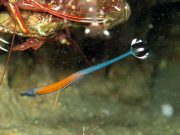Diving with Pipefishes
Lanta Marine Life | Syngnathinae
Pipefishes are a subfamily of small fishes closely related to seahorses, indeed they look like straight seahorses, and have a long tube-like snout which ends in a small, toothless, narrow mouth which opens upward. The body in encased in bony rings, similar to a seahorse tail, and can sometimes be found while diving from Koh Lanta.
Pipefish have long, thin bodies and are snake-like. The majority of these fish have tail fins, however some have tails similar to seahorses, in that they can curl and attach or hold objects.
All species have a dorsal fin, which is the main method of swimming, with other fins absent or underdeveloped in most species. They are slow, weak swimmers.
Females deposit eggs with the male, who fertilises and takes care of them. The male broods the offspring on either a distinct area of its body or in a brood pouch, depending on the species.
2 species found on this page:
Short-Tailed Pipefish
(Trachyrhamphus bicoarctatus)

Trachyrhamphus bicoarctatus @ Koh Haa
The short-tailed pipefish is a slender fish with a very small tail and grows up to 40 cm in length. This is a solitary fish living in sand, rubble and weeds around coral reefs and can be found down to 25 m.
The short-tailed pipefish can be black, or shades of green, brown, white and yellow with fine speckling. In addition to its short tail, this species can also be distinguished by its head often being raised, with a bent-neck, facing into the water column to feed on passing zooplankton.
Janss' Pipefish
(Doryrhamphus janssi)
As with other Syngnathiformes, the Janss' Pipefish has a long, slender body, with an elongated, tubular mouth. The main body colour is bright orange. The head and rear body are blue. The black tail is flag-like, with a white margin and white dot in the center.

Doryrhamphus janssi @ Phi Phi Palong
The Janss' Pipefish is a cleaner fish, feeding on parasites and dead tissue from damselfish and cardinalfish. This species grows to 14 cm and is often found swimming in pairs under rocky overhangs or under large plate corals.

Doryrhamphus janssi @ Phi Phi Palong
After an elaborate courtship dance, the female Janss' Pipefish attaches her eggs to a flat area on the underside of the male’s body, where the males will brood the young, similar to many seahorse species.
When brooding, the males will have a flattened appearance due to the brood pouch.
Diving with Pipefishes around Koh Lanta
Scuba Diving & Snorkel Trips
If you'd love a chance to spot Pipefishes on one of our daily high season diving trips from Koh Lanta then send us an email to info@diveandrelax.com.
Join our high season speedboat dive trips to some of Thailand's best dive sites and enjoy small groups, short journey times, with a focus on great personal service, safety and fun.
Not yet a certified diver? Learn to Scuba Dive on Koh Lanta with the 3 day SSI Open Water Diver course.
Book online to save 10% on dive trips and scuba courses on Koh Lanta.
Find Out More
Indo-Pacific Marine Life Guides
- Allen, G., Steene, R., Humann, P., DeLoach, N. (2003) Reef Fish Identification, Tropical Pacific. Jacksonville, FL., USA: New World Publications, Inc., ISBN 1-878348-36-1.
- Humann, P., DeLoach, N., (2010) Reef Creature Identification, Tropical Pacific. Jacksonville, FL., USA: New World Publications Inc., ISBN 978-1-878348-44-9
- Debelius, H. (2013) Indian Ocean Reef Guide. Frankfurt, Germany: IKAN - Unterwasserarchiv, ISBN 978-3-939767-52-7.
- Debelius, H. (2004) Nudibranchs and Sea Snails, Indo-Pacific Field Guide. Frankfurt, Germany: IKAN - Unterwasserarchiv, ISBN 3-925919-51-1
- Erhardt, H., Knop, D. (2015) Corals Indo-Pacific Field Guide. Frankfurt, Germany: IKAN - Unterwasserarchiv, ISBN 3-925919-69-4.
- Veron J.E.N., Stafford-Smith M.G., Turak E. and DeVantier L.M. (2016). Corals of the World
